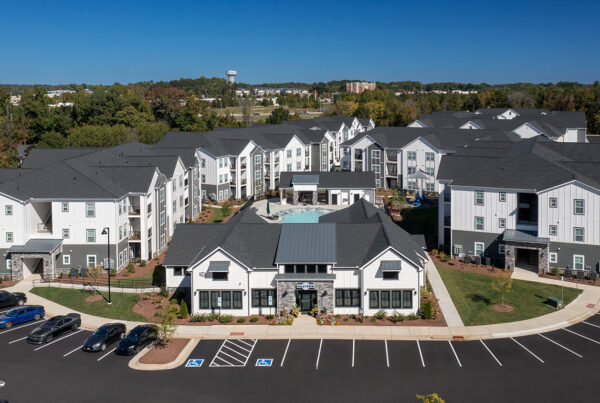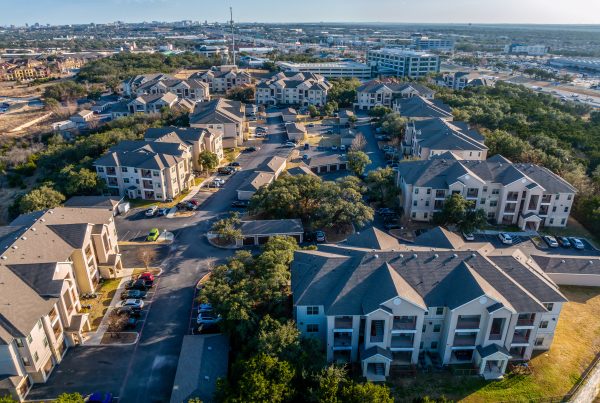US Multifamily Pricing and Transaction Volume are positioned to Rebound
The multifamily market appears poised towards an upward trend in the cycle. Following the dip in pricing and transaction volume in the US from 2021 and 2022, there are signs that both are rebounding. Importantly, this indicates that we may be entering an opportune window to acquire investments that benefit from a relatively low basis and upward-trending fundamentals.
In our recent white paper focused on multifamily supply, we expanded on several forces impacting the multifamily industry:
- An abundance of low-cost capital and strong multifamily fundamentals post-COVID contributed to the recent influx of new supply.
- Many of the factors that fueled the growing construction pipeline following the pandemic have shifted, which in turn caused the forward pipeline to drop sharply. Due to the projected construction slowdown, we expect new supply to return to historically average levels in 2025 and remain below average levels from 2026 through 2028.
- Markets vary in their ability to absorb new supply. Markets with strong demand drivers – population growth, job growth, and household formation – better absorb new supply, dampening the downward pressure on occupancy and rent growth.
- Lower levels of new supply beginning in 2025 are expected to boost occupancy and rent growth across the sector and in our portfolio.
With market uncertainty that has existed since mid-2022, multifamily property valuations have decreased 21% since their peak in Q2 2022, creating problems for assets with loan maturities in the heart of the downcycle. Similarly, transaction volume hit its lowest level in over a decade; average sales volume for the trailing four quarters is less than 50% of its pre-COVID average. This anemic sales activity was catalyzed largely by (i) uncertainty in capital markets (i.e. relatively high and unpredictable interest rates) and (ii) declining rents and increased vacancy as the high volume of new supply was absorbed. Both factors have negatively impacted pricing and motivation to sell.
We now believe that pricing and transaction volume are beginning to trend back up. As noted above, significant moderation of new supply is expected to drive rents up in the coming years, and we are beginning to see that take shape already. Nationally, month-over-month rent growth trends in the US are mirroring their “normal” pattern from 2010-2019. Rents were up 0.3% month-over-month in May 2024, which is in line with 2010-2019 when May month-over-month rents increased anywhere from 0.2-0.4%. Not coincidentally, the wave of new supply, a primary factor in the compressed or declining rent growth experienced in many markets, recently peaked, as the US added 179K units in Q2 2024. The pace of new supply is expected to decline over the next 9 quarters, averaging less than half of Q2 2024’s pace during that time and ultimately delivering just 52K units in Q3 2026. Considering price-per-unit is highly correlated with rents (0.96 correlation coefficient), we expect rising rents to positively impact property valuation and spur more investment activity.
Additionally, the uncertainty around interest rates, which has created hesitation in capital markets, is beginning to decrease. The federal funds rate has remained steady since July 2023, and spreads are beginning to tighten. Freddie Mac and Fannie Mae recently reduced spreads on conventional multifamily loans by 10 and 15 basis points, respectively. Through the first four months of 2024, multifamily spreads on CMBS loans tightened by 12 basis points, showcasing an increased appetite from lenders to transact.
Perhaps most telling, several recent large portfolio transactions showcase that other investment firms also believe the cycle is poised for an upswing. Blackstone acquired Apartment Income REIT and its 27,000 units in June for $10B. Separately, KKR recently completed a $2.1B transaction to acquire 5,200 units across the US from Quarterra. KKR noted in its press release for this transaction: “We believe this is a great moment to invest in real estate, as transaction activity starts to pick up on the heels of two-years of dislocation in commercial real estate market.” Additionally, it was recently announced that Brookfield has agreed to purchase 7,000 units from Starwood for $1.5B.
Collectively, we view these events as a signal that the cycle is swinging up. As a result of moderating supply and growing demand, we believe that Southeastern markets are on the cusp of increased rent growth. These factors combined with renewed confidence in capital markets, should drive multifamily valuations and performance upward. Several of the industry’s largest players are acting on this view, and we believe we will soon enter into an opportune window to acquire assets at an attractive basis before these variables fully feed into the system. While these forces should positively impact the industry at large, nuanced, local market expertise will be particularly critical to identify and execute on strategic investments in submarkets with favorable supply and demand fundamentals during this time to capture superior risk adjusted returns.







